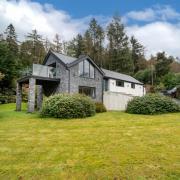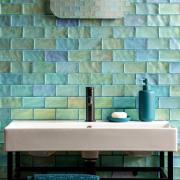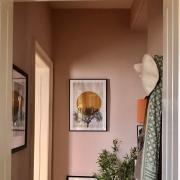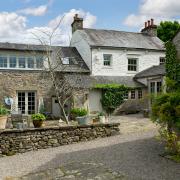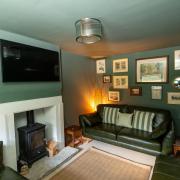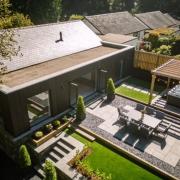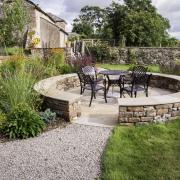Our world is full of pattern. Whether we realise it or not, we are deeply bonded to what we experience out in nature. Naturally occurring patterns are inherently soothing to we humans as they connect us to the natural world around us.
Taking inspiration from these patterns and shapes to design our homes can help us maintain a consistent and positive sense of wellbeing.
Biophilic design can help guide these inspirations from nature so that we can design the most comfortable built environments. With informed design choices, we may harness the benefits of the natural world so that these patterns can work quietly in the background of our homes, helping to support us.
The universal patterns in nature can appear to be repetitive or chaotic, mathematical or organic. When you slow down enough to look in detail, you will see pattern is everywhere. Look closely at all surfaces in nature and you will find:
- Fractals and spirals – natural shapes with intricate detail that repeat forever: find seashells, fossils, pines cones, branching fractals like our lungs, tree branches, ferns or snowflakes.
- Curves, waves and ripples – soft and soothing, these undulating shapes can be found in rolling hills, sand dunes, clouds, pebbles, ripples in water or the patterns left in wet sand.
- Spots and stripes – these patterns are most often seen in animal skins or insects like bees and ladybirds, or animals like zebras. More abstract stripes exist in botanical species such as zebra grass or the spider plant.
- Circles – they are everywhere in nature: eyes, flower centres, seed heads or the patterns on butterfly wings.
- Cracks – most frequently seen as geological patterns found in rock formation, the shapes created in dried earth or the abstract shapes and form in tree bark.
- Tessellations and geometric – shapes that fit seamlessly together just like the hexagons found in honeycomb which is one of the most easily identifiable patterns from nature. These patterns can also be found in the scales of snakeskin or the shapes in a pineapple husk.
Our brains excel at recognising patterns, some researchers believe our evolutionary success has been based upon our superior ability to process complex patterns.
Research studies on the efficacy of biophilic design show us that patterns found in nature are soothing to our nervous systems. Whether this is through a visual connection to nature or the use of more abstract, biomorphic patterns and forms, the way in which our brain perceives patterns has an impact on our overall sense of wellbeing. Why?
It seems that when the brain is not working overtime to make sense of a pattern, it can be busy elsewhere taking care of our bodies, leading to a reduction in the production of cortisol, meaning it helps lower our stress levels.

HOW TO ADD PATTERN TO YOUR HOME
When it comes to choosing patterns for our homes, knowing we can make clever use of nature inspired pattern to support our physical and mental wellbeing means, with some consideration, you can add a touch of nature to every surface in your home.
The key point to remember is that the physical placement of patterns is crucial to a creating harmonious spaces.
Where you would experience pattern and natural forms visually in nature is your guide to where to place them in your home. For example, clouds would appear above and around you not below, or the bark of a tree is likely to be in your eyeline not directly above your head.
Placing patterns in the natural order of where they are found in nature creates more harmony in your space.

BIOMORPHIC INSPIRED FURNITURE
Biomorphic patterns and forms are symbolic references to pattern, textures and shapes found in nature. Spaces which include biomorphic pattern or forms will often feel more energetic and absorbing than spaces without. Subconsciously natural shapes sooth us.
In recent years there has been a delightful shift towards curvy, more organic edges in furniture. Opting for soft undulating lines can really help you reference the contours of nature into your home – remember there are no straight lines or right angles found in nature.
The home of Czech artist and sculptor Jan Skacelik (Instagram @janskacelikart) is a wonderful example of how a space can blend organic shapes and forms. Jan combines the abstract shapes and geometric patterns in his artwork with the organic, flowing lines of his furniture.
The soft curving sofa, rounded chairs and flowing coffee table bring both a soothing, comfortable appeal and a playful feel. There is a sense that these natural free flowing shapes and curvy lines make the space feel creative and free from restriction, ideal for the creative mind.

WALLPAPER AND MURALS
Walls are an obvious choice for injecting pattern into your home. These days wallpaper, and specifically murals, have become something more akin to art than a simple repeating pattern backdrop for your interior.
From its origins in mid 1500s, wallpaper boomed in the average domestic setting from the early part of the 20th century. It has traditionally always favoured naturalistic imagery with floral and botanical themes and remains one of the most dramatic ways to bring pattern into your home.
For the truly immersive pattern experience, the bold will favour a full-on, wall to wall pattern experience, but this is not for the fainthearted. With so many incredible patterns, realistic imagery and life size scale available, it has never been easier to immerse your home in the drama of nature.
The pattern filled home of lifestyle and interiors blogger Caro Davies is one of my favourites to be found on Instagram (@thelistedhome/thelistedhome.co.uk). Caro knows how to bring nature into her unique home using bold pattern in all the right places.
Living in a quirky listed building means wallpapering can be quite a challenge but what Caro has achieved with pattern is inspirational for anyone who lives in an older home of character.
The hallway in this 400-year-old building is quirky to say the least, with several doorways, not a straight line in sight and beams galore. Caro could not find a paint colour she liked and traditional pattern wallpapers would only serve to accentuate the quirks and wonky lines.
Choosing a bespoke illustrated mural from French company, Les Dominotiers (dominotiers.com/en/) has delivered the perfect solution for the space.
This design appears to grow from the ground up; rather than working against the character of the space, it serves to enhance it. If you have a space that is full of charm and character, consider a design such as this.
By opting for a free flowing, organic illustration that doesn’t extend the whole height of the roll, the eye isn’t immediately drawn to uneven ceiling lines. The overall effect is one of being immersed in a flower meadow, which makes for a delightful way to experience this transitional space between rooms.
Smaller, more subtle pattern offers a soothing backdrop to your interior.
Small pattern doesn’t have to be overly rigid or stylistic, it can still feel organic and natural even when repeated.
The botanical wallpaper designs of Yorkshire artist Hannah Nunn are a perfect example. With a soft and muted colour palette, Hannah’s collections are delicate, elegant and graceful – much like the wistful botanicals that are her muse.

My favourite is Paper Meadow (shown here in Harvest), perhaps because I love the delicate form of cow parsley and dandelion clocks.
Murals have had a revival in recent years and now there is an array of incredible designs on the market; the choice is endless.
Whist the idea of a ‘feature wall’ is a design choice often considered a dirty word to some designers (because all too often it’s just a random wall colour), a wallpaper mural on a single wall can look very chic. It feels more deliberate and adds so much more interest than a flat colour.

TILES
Tiles offer another fantastic opportunity to incorporate nature into your home. Bold tile patterns can dramatically change any space and represent an exciting way to bring pattern to life. You can bring patterns of nature into your tiling through texture, shape or pattern design.
The advances in manufacturing and photographic techniques mean your choice of tile is now vast and incredibly realistic.
Digital printing onto porcelain means you can have extremely realistic wood effect tiles for example. These tiles have the appearance and texture of wood, it’s only when you get remarkably close and touch them that you know.
Wood effect porcelain makes an ideal, easy-care choice for bathrooms or kitchens when you don’t want the upkeep of real wood.
Tile shapes can bring in fractal or tessellation patterns into the home and can look especially effective when you combine with other nature inspired patterns or shapes.
In one of my current design projects, we are teaming a terracotta snowflake/flower pattern floor tile with a simple hexagon wall tile in the same colour – both tiles feature soothing natural pattern and shape.
Hexagon tiles are a particular favourite of mine. In another bathroom project we are combining matt green, hexagon floor tiles with green and off-white stripe tiles in the shower area.
It is easy to play it safe with tiles and opt for a classic or a neutral, but if you follow your gut instinct and choose a pattern you love (not one just driven by latest trends), I doubt you will regret it.

ALL IN THE DETAILS
If being bold with wallpaper or committing to tiles is a step you are not ready to take just yet, you can easily embrace nature patterns into your home with soft furnishings and decorative accessories or lighting.
The good news is that nature inspires so many designers that you are never far from a beautiful botanical fabric or a naturalistic ornament. There is plenty of choice to suit your taste, be it abstract, realistic or illustrative in design.
Just don’t be afraid to mix it up: overly matched accessories tend to look dated whereas combining style and patterns feels contemporary by adding more depth and interest.
Just keep in mind that natural fibres rule in biophilic design so always look for linen, cotton or hemp and avoid anything with synthetic fibres.
When it come to mixing your patterns, a stripe is always a clever idea to add interest; it is an easy pattern mix win even if you are not confident at mixing patterns.
Look for brands or designers who make it easy for you and have already created co-ordinating ranges like this perfect example from Cabbage & Curtainrail. The Songbird (in Paris green) design features stylised pattern of graceful swallows, teamed up with their Haldane stripe in the same colourway. Stripes, birds, botanicals and green – it is the dream, nature-inspired combination.

DECORATIVE OBJECTS
Decorative objects are an instant way to update your space with both natural texture and form.
In my own home I found this vintage carved wooden bowl on eBay that looks just like the underside of a field mushroom. I don’t know if this was the inspiration or intention behind it, but every time I look at the bowl, I think mushroom.
Keep an eye out for ornaments with textures that remind you of something you have seen out in nature as these will help you connect to natural textures in the same way.

WOOD GRAIN
Real wood is my favourite natural material and, as a designer, it is my favourite natural pattern to bring into a home.
A research project by biophilic design specialist Terrapin Bright called The Nature of Wood is an exploration of the science behind our responses to wood.
Investigations concluded that above all the elements which make wood so appealing to humans – colour, warmth, smell, texture – it is seeing the actual grain of the wood that our brains find so soothing.
The colinear pattern of wood grain is easily understood by our brain. Being so easily recognised and processed, wood patterns cause no stresses in the brain making it the best possible pattern to live with.
Choosing real wood furniture and accessories for our homes which depict the pattern and texture of the wood, or pieces showing the knots in the grain, creates an underlying sense of wellbeing.
The grain of walnut wood is clearly visible in this beautiful Urchin table lamp by Tom Raffield, inspired by sand combed shells. The lamp combines organic form with the soothing patterns from nature and when lit the light and shadows it creates are simply delightful.
Follow Sharon on Instagram @a_story_of_home
Next month: our biophilic lens will focus on wood in more detail and explore ways to use more of it in our home.






